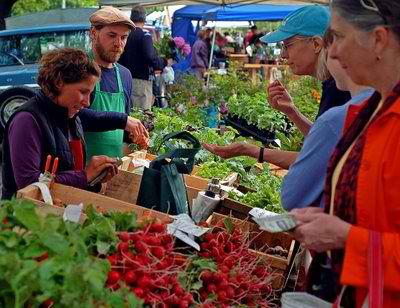Senate Panel Talks Local Food for Upcoming Farm Bill

Secretary of Agriculture Tom Vilsack says that local food is one of the fastest growing segments of agriculture, with direct consumer sales doubling in the past decade to reach close to $5 billion in 2008. Vilsack, and a panel of agriculturalists from across the U.S. provided testimony before the Senate Committee on Agriculture, Nutrition, and Forestry. The March 7 Healthy Food Initiatives, Local Production, and Nutrition hearing provided something of a status report, as well as a refined set of objectives for promoting the local food movement with federal policy.
“More than ever, consumers are interested in where their food comes from and are seeking out a connection to the men and women who put food on our tables,” Vilsack told the committee. “Buyers in every sector of the food system have increased local food purchases, and conversations between farmers and consumers are taking place every day in every part of the country.”
The only farmer on the panel, Mr. Jody Hardin, gave encouraging testimony about the economic security to be found in local and regional food production and sales.
“I have been participating in farmers markets for over 26 years, the income from which I used to fund my college education,” testified Hardin.
“In addition to being a farmer, I am also an entrepreneur. I was the founder of the All Arkansas Basket a Month CSA that has served nearly 200 families with locally grown food year-round for the last six years, and I am proud to say, with great success. This cooperative buying program serves nearly 40 farmers and was a catalyst that seemed to spawn a local foods movement in central Arkansas that continues to expand today.”
Hardin says he currently owns 1,000 acres, with about 50 percent of it leased to conventional row-crop farmers.
“We raise nearly 150 acres in vegetables each year that are sold in regional wholesale markets and directly to consumers through a Community Supported Agriculture (CSA) program with 80 family subscribers and in our own farm stores that feature local and regional specialty crops,” Hardin told the Senate panel.
Hardin is also founder and president of the non-profit Certified Arkansas Farmers Market, which got its local food movement off the ground in 2007. Committee chairwoman and Michigan Senator Debbie Stabenow asked Hardin how “the local community around the market has developed.”
His response:
“I’ve witnessed something I’ve never seen before...we’ve seen a blighted area – no one would ever come down to this part of town – (change with) new restaurants, new grocery stores. There has been tremendous community investment and support. Now, I think there are over 1,200 homes planned in the downtown area. People want to live there, we’re building walk-able communities. Everyone around central Arkansas has witnessed this growth and now wants to create their own farmers market and help their farmers.”
Dan Carmody, president of Michigan’s Eastern Market Corporation said that such results are an illustration of what can happen “when you take light-rail and a transportation system investment and add it on to a local food system investment.”
“You really get miraculous results,” Carmody emphasized. “It’s an example that in an austere fiscal world you can add 2 plus 2 and get 10.”
Other issues discussed included ways to make food stamps more widely accepted at farmers markets and how states can work best to get local and regionally grown food to schools.
Hardin and colleagues emphasized a need for “aggregation processing facilities geared directly for our schools.” The biggest concern from the schools, Hardin said, is that there is no inventory of local food, a drawback for institutions that require meal planning throughout the school year.
The witnesses also agreed on a need for more organized local food distribution centers. USDA officials hope that their promotion of food hubs, which handle distribution needs for a plurality of small, regional producers, will help fill food distribution gaps.




